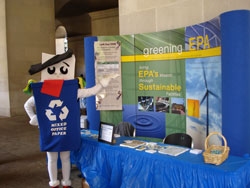Waste Diversion
In This Section
Waste diversion is the prevention and reduction of generated waste through source reduction, recycling, reuse, or composting. Waste diversion generates a host of environmental, financial, and social benefits, including conserving energy, reducing disposal costs, and reducing the burden on landfills and other waste disposal methods.
Waste Diversion at EPA
For many years, EPA has established waste diversion goals that exceed current federal requirements. EPA regional offices, laboratories, and Headquarters have in place recycling programs to make it easy and convenient for employees to recycle. By promoting and expanding these programs, EPA facilities improved the Agencywide waste diversion rate from an estimated 39 percent in fiscal year (FY) 2006, the first year the Agency measured its waste diversion rate, to an estimated 51 percent in FY 2009, based on data available from facilities. This exceeded EPA’s target of a 45 percent waste diversion rate by 2010, which the Agency set under the requirements of Executive Order (EO) 13423.

EPA's recycling mascot, Slim Bin, next to an Earth Day display.
EO 13514, “Federal Leadership in Environmental, Energy, and Economic Performance,” signed on October 5, 2009, set a new solid waste diversion rate goal for all federal agencies—50 percent by FY 2015, a goal which EPA has already met.
EPA continues to develope goals and strategies to guide the waste diversion activities its facilities undertake. These facilities' efforts have produced results, such as reducing the amount of waste sent to landfills and designing and operating more sustainable facilities. Learn more about waste diversion.
![[logo] US EPA](https://webarchive.library.unt.edu/web/20120926084902im_/http://www.epa.gov/epafiles/images/logo_epaseal.gif)